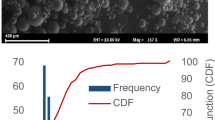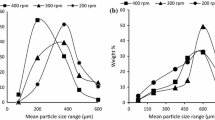Abstract
Purpose. The goal of the present paper was to investigate the role of a surfactant, Tween 20, in the modulation of the entrapment and release of β-lactoglobulin (BLG) from poly (DL-lactide-co-glycolide) microspheres.
Methods. Poly(DL-lactide-co-glycolide) microspheres containing BLG were prepared by a water-in-oil-in-water emulsion solvent procedure. Tween 20 was used as a surfactant in the internal aqueous phase of the primary emulsion. BLG entrapment efficiency and burst release were determined. Displacement of BLG from microsphere surface was followed by confocal microscopy observations and zeta potential measurements, whereas morphological changes were observed by freeze-fracture electron microscopy.
Results. Tween 20 was shown to increase 2.8 fold the encapsulation efficiency of BLG without any modification of the stability of the first emulsion and the viscosity of the internal aqueous phase. In fact, Tween 20 was shown to be responsible for removing the BLG molecules that were adsorbed on the particle surface or very close to the surface as shown by confocal microscopy and zeta potential measurements. Tween 20 reduced the number of aqueous channels between the internal aqueous droplets as well as those communications with the external medium. Thus, the more dense structure of BLG microspheres could explain the decrease of the burst release.
Conclusions. These results constitute a step forward in the improvement of existing technology in controlling protein encapsulation and delivery from microspheres prepared by the multiple emulsion solvent evaporation method.
Similar content being viewed by others
REFERENCES
D. Gilding and A. M. Reed. Biodegradable polymers for use in surgery polyglycolic/poly (lactic acid) homo and copolymers. Polymer. 20:14529–1464 (1979).
S. J. Challacombe, D. Jeffrey, S. S. Davis, and D. T. O'Hagan. Enhanced secretory IgA and IgG antibody responses after oral immunization with biodegradable microparticles containing antigen. Immunology 76:164–168 (1992).
M. J. Alonso, R. K. Gupta, C. Min, J. R. Siber, and R. Langer. Biodegradable microspheres as controlled-release tetanus toxoid delivery systems. Vaccine 12:299–306 (1994).
K. Allaoui-Attarki, S. Pecquet, E. Fattal, E. Chachaty, P. Couvreur, and A. Andremont. Protective immunity against S. typhimurium elecited in mice by oral vaccination with phosphorylcholine encapsulated in poly(D, L-lactide-co-glycolide) microspheres. Infect. Immun. 65:853–857 (1997).
Y. Ogawa, M. Yamamoto, H. Okada, T. Yashiki, and T. Shimamoto. A new technique to efficiently entrap leuprolide acetate into microcapsules of polylactic acid or copoly (lactic/glycolic) acid. Chem. Pharm. Bull. 36:1095–1103 (1988).
M. Iwata and J. McGinity. Dissolution; stability and morphological properties of conventional and multiphase poly(DL-lactic-co-glycolic acid) microspheres containing water-soluble compounds. Pharm. Res. 10:8, 1219–1227 (1993).
M. J. Blanco-Prieto, F. Delie, E. Fattal, A. Tartar, F. Puisieux, and P. Couvreur. Characterization of V3 BRU peptide-loaded small PLGA microparticles prepared by a (W/O/W) emulsion solvent evaporation method. Int. J. Pharm. 111:137–145 (1994).
R. Alex and Bodmeier. Encapsulation of water soluble drugs by a modified solvent evaporation method. I. Effect of process and formulation variables on the drug entrapment. J. Microencapsul. 7:347–355 (1991).
T. Heya, H. Okada, Y. Tanigawara, Y. Ogawa, and H. Toguchi. Effects of counteranion of TRH and loading amount on control of TRH release from copoly(dl-lactic/glycolic acid) microspheres prepared by an in water drying method. Int. J. Pharm. 69:69–75 (1991).
H. Jeffery and R. Boldmeier. The preparation and characterization of poly(lactide-co-glycolide) microparticles. II. The entrapment of a model protein using a (water-in-oil)-in-water emulsion solvent evaporation technique. Pharm. Res. 10:362–368 (1992).
J. Herrmann and R. Boldmeier. Somatostatin containing biodegradable microspheres prepared by a modified solvent evaporation method based on W/O/W multiple emulsions. Int. J. Pharm. 126:129–138 (1995).
H. Rafati, A. G. A. Coombes, J. Adler, J. Holland, and S. S. Davis. Protein-loaded poly(DL-lactide-co-glycolide) microparticles for oral administration: formulation, structural and release characteristics. J. Contr. Rel. 43:89–102 (1997).
E. Leo, S. Pecquet, J. Rojas, P. Couvreur, and E. Fattal. Changing the pH of the external aqueous phase may modulate protein entrapment and delivery from poly(lactide-co-glycolide) microspheres prepared by a w/o/w solvent method. J. Microencapsul. 15:421–430 (1998).
C. N. Schugens, N. Laurelle, C. H. Nihant, C. H. Granfils, R. Jerome, and P. H. Teyssie. Effect of the emulsion stability on the morphology and porosity of semicrystalline poly L-lactide microparticles prepared by w/o/w double emulsion-evaporation. J. Contr. Rel. 32:161–176 (1994).
M. J. Blanco-Prieto, E. Leo, F. Delie, A. Gulik, P. Couvreur, and E. Fattal. Study of the influence of several stabilizing agents on the entrapment and in vitro release of pBC 264 from poly(lactide-co-glycolide) microspheres prepared by a w/o/w solvent evaporation method. Pharm. Res. 13:1137–1139 (1996).
M. J. Blanco-Prieto, E. Fattal, A. Gulik, J. C. Dedieu, B. Roques, and P. Couvreur. Characterization and morphological analysis of a cholecystokinin derivative peptide-loaded poly (lactide-co-glycolide) microsphere prepared by a water-in-oil-in water emulsion solvent evaporation method. J. Contr. Rel. 43:81–87 (1997).
H. K. Sah, R. Toddywala, and Y. W. Chien. Biodegradable microcapsules prepared by a w/o/w technique: effects of shear force to make a primary w/o emulsion on their morphology and protein release. J. Microencapsul. 12:589–69 (1995).
J. L. Courthaudon, E. Dickinson, Y. Matsumara, and D. C. Clark. Competitive adsorption of β-lactoglobulin + Tween 20 at the oil-water interface. Colloids Surf. 56:293–300 (1991).
J. Chen and E. Dickinson. Protein/surfactant interfacial interactions Part 3. Competitive adsorption of protein + surfactant in emulsions. Colloids and Surfaces A: Physicochemical and Engineering Aspect. 101:77–85 (1995).
S. M. Hora, R. K. Rana, J. H. Nunberg, T. R. Tice, R. M. Gilley, and M. Hudson. Release of human serum albumin from poly(lactide-co-glycolide) microspheres. Pharm. Res. 7:1190–1194 (1990).
Y. F. Maa and C. C. Hsu. Effect of primary emulsion stability on microsphere size and protein-loading in the double emulsion process. J. Microencapsul. 14:225–241 (1997).
N. Nihant, C. H. Schugens, C. Grandfils, R. Jerome, and P. H. Teyssie. Polylactide microparticles prepared by double emulsion/evaporation technique. I. Effect of primary emulsion stability. Pharm. Res. 11:1479-1484 (1994).
T. Verrecchia, P. Huve, M. Veillard, G. Spenlehauer, and P. Couvreur. Adsorption/desorption of human serum albumin at the surface of poly(lactic acid) nanoparticles prepared by a solvent evaporation process. J. Biomed. Materi. Res. 27:1019–1028 (1993).
E. Dickinson and S. Hong. Surface coverage of β-lactoglobulin at the oil-water interface: influence of protein heat treatment and various emulsifiers. J. Agric. Food Chem. 42:1602–1606 (1994).
Author information
Authors and Affiliations
Corresponding author
Rights and permissions
About this article
Cite this article
Rojas, J., Pinto-Aiphandary, H., Leo, E. et al. A Polysorbate-Based Non-Ionic Surfactant Can Modulate Loading and Release of β-Lactoglobulin Entrapped in Multiphase Poly(DL-Lactide-co-glycolide) Microspheres. Pharm Res 16, 255–260 (1999). https://doi.org/10.1023/A:1018880409254
Issue Date:
DOI: https://doi.org/10.1023/A:1018880409254




